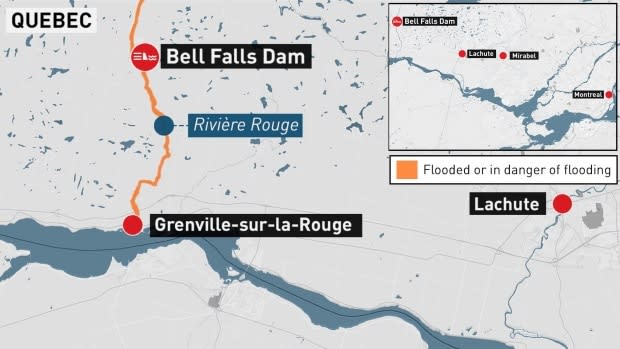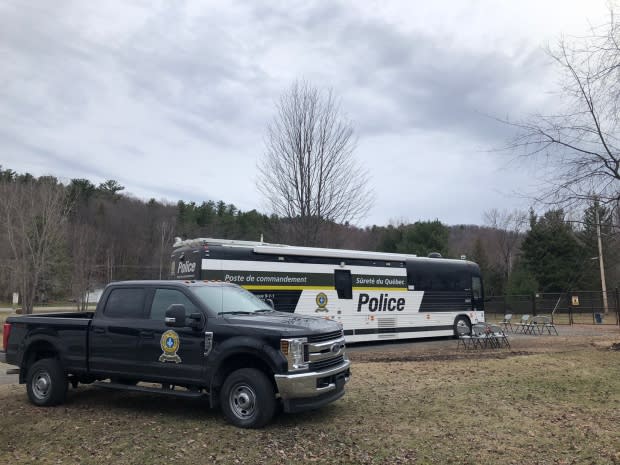Evacuation complete downstream of Bell Falls Dam. Now western Quebec town watches and waits
Quebec authorities say they are confident that the Bell Falls Dam in Quebec's western Laurentians will withstand never-before-seen river levels, but that precautionary evacuations of highest-risk areas downstream are complete.
"Every person who was located in the risk area in Grenville-sur-la-Rouge has been evacuated as a preventive measure," Quebec Public Security Minister Geneviève Guilbault said Friday.
"Safety has been assured."
Hydro-Québec officials "are still confident that the dam will resist the flow, but if it doesn't, no one is at risk," Guilbault said.
On Thursday, water levels at the dam on the Rouge River hit the extreme limit for which the structure was built, triggering a mandatory evacuation process.
Hydro-Québec says the dam is designed to withstand a "thousand year" flood — which means a flood that has a 0.1 per cent chance of occurring — and the utility is confident it will hold even as water levels rise beyond that limit.
With rain expected, the flow rate may increase by another 30 per cent in the next few days, Hydro-Québec spokesperson Francis Labbé said Friday.
Because of that, "we cannot legally and morally guarantee that the structure will be able to hold such a pressure," he said.
If the dam were to give way, people would have less than an hour to escape the surging water, said federal Public Security Minister Ralph Goodale during a Friday morning news conference.
"The wise thing is to get out in advance of a problem and not wait until the last minute," he said.

Some refuse to leave their homes
Bell Falls, or Chute-Bell, is about 23 kilometres northwest of Grenville-sur-la-Rouge, Que., which is on the north side of the Ottawa River, across from Hawkesbury, Ont.
Provincial police said about 60 people have been obliged to leave their homes so far. They were all mandatory evacuations, but town officials and police are also urging residents in rural regions beyond the highest risk areas to leave their homes.
Officials said some 250 people total are being encouraged to vacate the Grenville-sur-la-Rouge area.
Provincial police Sgt. Daniel Thibaudeau said evacuations have been going well considering the size of the operation.
Most people were taken out by land, but about 15 were airlifted to safety by helicopter because their homes were completely surrounded by water.
"It's a huge undertaking," Thibaudeau said, speaking to CBC at a command post that provincial police have set up in the vicinity as evacuations continue Friday.

"It's a rather complex territory, there are some houses you just cannot get to by land, they're surrounded by water."
Despite the warnings from Hydro-Québec engineers and the province's public security minister, Arnold said some people are refusing to leave.
"Those are the ones I've been trying to convince and explain to them why they need to evacuate," said Arnold, who grew up in the area.
Watch helicopter footage of the dam at risk of failing:
"I think it's just a matter of communicating the dangers to them face to face. And I think that we'll get everybody's co-operation."
Some 150 properties — a mix of homes, camps and businesses — are at risk, and Grenville-sur-la-Rouge Mayor Tom Arnold said his top priority is making sure nobody is left behind. Material items can be replaced, Arnold said, but lives cannot.
Like Arnold, many people have lived in the area their entire lives and, while they are used to the river flooding nearly every spring, it's never been this bad, he said.
"It's what they call the 1,000-year flood," he said. "So we're keeping our fingers crossed."
Mayor told dam had collapsed
Arnold was inspecting camps and a campground near where the Ottawa and Rouge rivers meet when a radioed message told him the dam had collapsed.
He imagined a wall of water rushing down through the valley, wiping out the population.
He told kayakers to get out of the water and sent rescuers north to begin emergency evacuations.

All the while, he was thinking of those living along the river.
"You see all the people you know and you see their faces in your mind and you think of the worst," said Arnold.
"So it was a huge relief when we were told the structure was still there."


